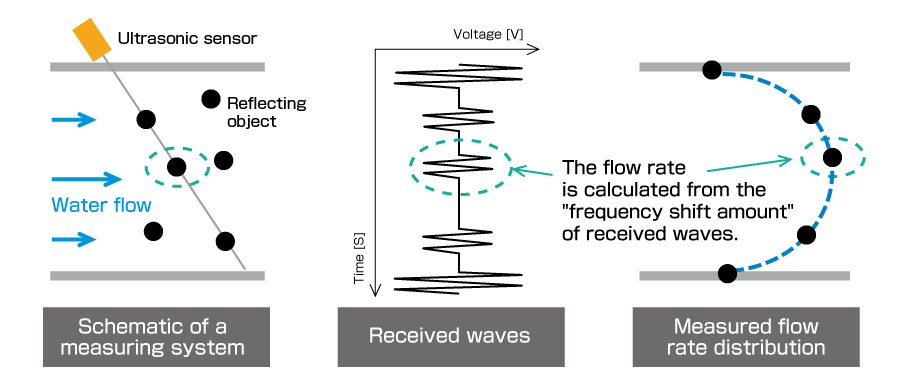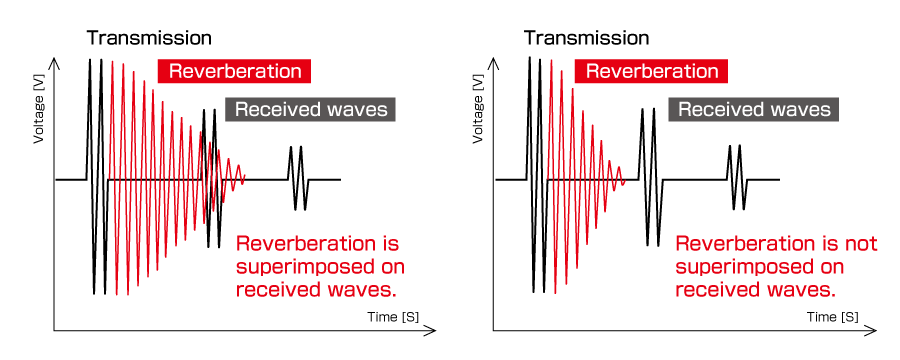Visualized water flow with ultrasonic waves; Research and development that cope with drift flow or pulsating flow

Nowadays flow meters are used in a wide variety of fields such as measurement of gases and tap water, transactions of natural gases and petroleum, flow rate control in factories, agricultural water control in growing non-paddy crops, etc. Concerning the measurement of an accurate flow rate, the measured values of a flow meter play an important role in various fields such as fair transaction fees, the yield and performance improvement of products, process risk management, energy saving and cost reduction, and others.
There exist various types of flow meters in the world, and we need to select a flow meter appropriately depending on the fluid to be measured or an environment in which measurement is made. But most of such flow meters presuppose stable flow, and there are not many types of flow meters that enable accurate measurement to be made even when there is drift or pulsating flow.
Among them, flow meters of the ultrasonic flow rate distribution type※ employ a technology that directly measures the flow rate distribution in a pipe by utilizing the Doppler effect of ultrasonic waves, which enables accurate measurement of flow that is not axially symmetrical such as drift flow.
※Advocated by Mr. Yasushi TAKEDA, Special Researcher at Swiss Federal Institute of Technology, Professor Emeritus at Hokkaido University
Measuring principles
Flow meters of the ultrasonic flow rate distribution type employ a technology that measures the flow rate by irradiating ultrasonic waves onto a fluid and detecting Doppler signals from the reflecting objects inside the fluid. Hence, it is required that there should be flowing objects that reflect ultrasonic waves (bubbles and very small trashes, etc.) in the fluid. When the irradiated ultrasonic waves have been reflected by the objects in the fluid, frequencies that have been shifted slightly from the frequencies of the irradiated ultrasonic signals are returned by the Doppler effect. Since the amount of such shift corresponds to the velocity of movement of the reflecting objects (≒flow rate of the fluid), the flow rate can be calculated by detecting the difference between the frequencies of transmitted signals and received signals. In addition, since the time from the irradiation of ultrasonic waves to the return of signals from the reflecting object corresponds to the distance from the sensor to the reflecting object, the position of the reflecting object can be identified. That is, by plotting the positions and velocities of multiple reflecting objects, the flow rate distribution can be obtained.

Ultrasonic sensor that suppresses reverberation
When transmitting from a ultrasonic sensor, sound waves are transmitted by converting electric energy into vibration energy. But even when the supply of electric energy has been stopped, the vibration of the ultrasonic sensor does not converge soon. This is called “reverberation”. In the measuring method employed this time, since the transmission and receiving of ultrasonic waves are done with one sensor, if the reverberation of at the time of transmission is superimposed on received signals, an error is generated in the result of measurement. Consequently in order to suppress reverberation while securing necessary signals, an ultrasonic sensor having little reverberation has been realized by reexamining basic structure such as the materials of a piezoelectric body and a filler that constitute the ultrasonic sensor.

System that enables very small frequency shifts to be detected
The frequency that is shifted by the Doppler effect is around several % of the fundamental frequency of the ultrasonic sensor at the most. In order to detect a very small frequency shift such as this, a calculating unit is required that calculates signals having a high S/N ratio and the frequency deviation. Received signals having a high S/N ratio have been realized with a pulser-receiver equipped with a band pass filter and a low noise amplifier, and the calculating unit has been realized with our unique algorithm based on an autocorrelation method under the technical guidance of Associate Professor Hiroshige KIKURA of Tokyo Institute of Technology and Assistant Professor Tomonori IHARA of Tokyo University of Marine Science and Technology.
Voice of a developer

■ Achieving results in a limited period of time -Takahiro Fujii
At first when I started the research, experiment facilities were available only at our collaborative research partner, I had to go back and forth between Nagoya and Tokyo. I felt pressure because the research field was unknown to me and there was the need to achieve results in a limited period of time, but it was a good experience for me.
I think that this ultrasonic Doppler measuring technology has a high potential that enables invisible fluid movement to be visualized. I will go forward undauntedly in future as well, so that the technology will be improved and the research can be led to commercialization.
■ Getting closer to realization by repeatedly making prototypes -Keisuke Kunii
I was mainly in charge of the design of the ultrasonic sensor. Since I participated in this theme halfway, I studied ultrasonic Doppler sensing from scratch, and engaged in the design while seeking advice from my senior colleagues and superiors as to what kind of ultrasonic sensor is appropriate in terms of its performance. And by making prototypes repeatedly, I could come closer to the realization of an ultrasonic sensor having performance fit for ultrasonic Doppler measurement.
■ Started the research, having little knowledge about it -Yukihiro Matsuoka
At the initial stage of the research, due to my still shallow experience and because the measuring method was different from that of the existing products, I had so little knowledge about the research. But during the course of verification using prototypes, I received a lot of advice and could deepen my knowledge, and therefore now I think I could have received very good opportunities. I would like to pursue this research further and endeavor to improve the functions of existing products in future as well.
■ Developing a new ultrasonic sensor from scratch -Shin Watanabe
I was engaged in the research as a person in charge of design of the ultrasonic sensor. Because the measuring principles had not been in our store of knowledge, such as making ultrasonic waves strike the inside of the fluid from the outside of the pipe, and detecting Doppler signals from received ultrasonic signals, and others, I had to develop a new ultrasonic sensor from scratch. For this reason, we had so many difficulties with many portions that required us to grope for solutions, such as those in which we had to determine by ourselves even evaluation items for making judgment on whether a finished prototype sensor is good or not, as well as the standard values and evaluation methods, in addition to the design items required for the realization of functions.
I would like to accumulate the knowledge that has been acquired this time, and also to exploit it in the development of new ultrasonic sensors from now on.